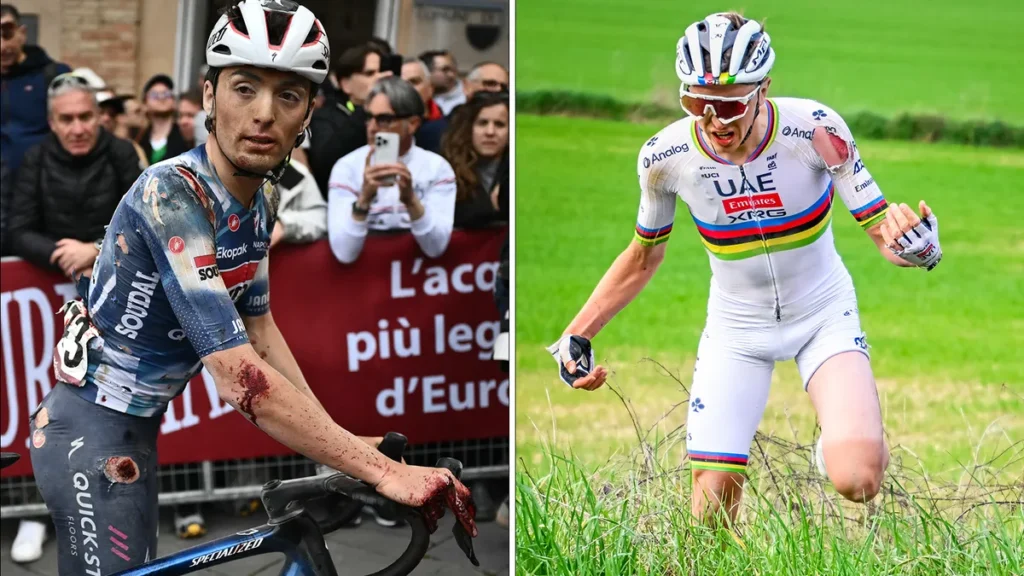
The 2025 edition of Strade Bianche will be remembered not just for its thrilling racing but also for the sheer number of crashes that wreaked havoc on the peloton. This prestigious one-day classic, known for its picturesque yet brutal gravel roads, saw several high-profile riders hitting the ground hard, with injuries ranging from deep cuts to fractured collarbones. The toll was particularly high on riders like Max Poole and Stan Dewulf, both of whom suffered broken collarbones, while others crossed the finish line with bloodied faces and torn kits.
Brutal Conditions and High-Speed Crashes
Strade Bianche is famous for its white gravel roads, narrow sections, and sharp corners, making it one of the most technical and unpredictable races on the cycling calendar. However, this year’s edition proved to be exceptionally dangerous. With dry conditions causing excessive dust clouds and unpredictable wind gusts creating havoc, visibility was low, and traction became a serious issue.
One of the race’s defining moments came roughly 50 kilometers from the finish, when race favorite Tadej Pogačar crashed on a sharp turn. The Slovenian, despite sustaining abrasions to his left shoulder, quickly remounted and impressively bridged back to the lead group. Displaying his trademark aggression, Pogačar launched a devastating solo attack and powered to his third Strade Bianche victory.
However, not all riders were as fortunate. Moments after Pogačar’s incident, Michal Kwiatkowski, a two-time winner of the race, crashed on the same corner. Unlike Pogačar, Kwiatkowski was unable to continue and was forced to abandon the race, highlighting just how brutal the conditions were.
A High Attrition Rate and Devastating Injuries
The peloton suffered significant losses due to crashes, with only 98 of the 174 starters managing to finish. Among the early victims of the race were Max Poole (Picnic PostNL) and Stan Dewulf (Decathlon AG2R La Mondiale), both of whom sustained broken collarbones in separate crashes. Poole’s injuries required immediate medical attention, and his team later confirmed that surgery would likely be necessary. Similarly, Dewulf’s race ended prematurely with a fractured collarbone, ruling him out of competition for the foreseeable future.
Another major casualty was Emiel Verstrynge of Alpecin-Deceuninck, who suffered the same fate as Poole and Dewulf with a collarbone fracture. Meanwhile, his teammates Clement Berthet and Xandro Meurrisse were involved in a massive pile-up, with Berthet sustaining a deep knee wound that required stitches.
Krists Neilands (Israel-Premier Tech) fractured his wrist, while Javi Serrano (Polti VisitMalta) broke the head of his radius bone during an attempted bridge to the breakaway. Both riders are expected to be sidelined for an extended period, further depleting their teams for upcoming spring classics.
Women’s Race Equally Affected by Crashes
The carnage was not limited to the men’s peloton. The women’s race, contested over the same grueling terrain, saw several high-profile incidents. Kasia Niewiadoma, a consistent contender in Strade Bianche, suffered a terrifying crash into a guardrail and had to be hospitalized for further evaluation. Although her partner, former professional cyclist Taylor Phinney, confirmed she was recovering, concerns about her long-term condition remain.
Pauline Ferrand-Prévot, the Olympic mountain bike champion, also crashed heavily on a paved descent. Despite the setback, she displayed immense resilience, remounting her bike and fighting her way to a third-place finish. The French rider later remarked that she felt optimistic about her form, despite the setbacks in Siena.
Calls for Safety Measures and Race Reflection
While crashes are an inherent part of professional cycling, the high number of serious injuries in this year’s Strade Bianche has sparked discussions about safety measures. Riders and teams have called for improved course management, including better warning signs at hazardous corners and increased gravel maintenance to reduce loose sections.
Despite the chaos, the race remains one of the most beloved events on the calendar. The demanding nature of the course and the unpredictability of the conditions are part of what makes Strade Bianche such an iconic race. However, as the dust settles on this crash-filled edition, many will be hoping that future iterations of the race can balance its thrilling spectacle with enhanced safety measures.
For now, the injured riders face a tough road to recovery, while the cycling world looks ahead to the rest of the spring classics, hoping for less drama and more clean racing.
Leave a Reply